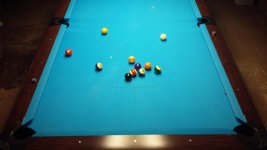In this situation the 12 ball is a classic break ball for the next rack (I'm left handed). The question is whether you save the 12 as your break ball and try to get though the rack, or shoot the 1 and then use the 12 to break up the rest of the cluster right away?
The 13 is too straight, even with cheating, to open up the cluster. The 8 is almost a dead carom into the lower right pocket and can be made easily. The 11 doesn't go anywhere and there are no good combos.
I don't like breaking into clusters without a safety ball, but sometimes you have to do it. Is this one of those situations?
Here was my thinking: Shoot the 1 and follow to the rail for the 3. Follow down to the cube of chalk on the left rail for the 8 ball carom. Shoot the 8 carom medium soft with a little draw so that the 11 moves the 10 and 4 out, and you may get a little luck and get position on the 13 in the side or the corner (that's my safety ball). Worst case scenario I most likely have the 12 in the side or corner as a safety ball if I have to take it.
In reality the cue ball skipped/skidded when I hit the 3 and I didn't get any follow.
Larger picture question: How strongly do you want to keep that break ball in tact? I know there was one player (was it Mizerak?) who routinely shot in the break balls if it helped him get to the rest of the rack.
The 13 is too straight, even with cheating, to open up the cluster. The 8 is almost a dead carom into the lower right pocket and can be made easily. The 11 doesn't go anywhere and there are no good combos.
I don't like breaking into clusters without a safety ball, but sometimes you have to do it. Is this one of those situations?
Here was my thinking: Shoot the 1 and follow to the rail for the 3. Follow down to the cube of chalk on the left rail for the 8 ball carom. Shoot the 8 carom medium soft with a little draw so that the 11 moves the 10 and 4 out, and you may get a little luck and get position on the 13 in the side or the corner (that's my safety ball). Worst case scenario I most likely have the 12 in the side or corner as a safety ball if I have to take it.
In reality the cue ball skipped/skidded when I hit the 3 and I didn't get any follow.
Larger picture question: How strongly do you want to keep that break ball in tact? I know there was one player (was it Mizerak?) who routinely shot in the break balls if it helped him get to the rest of the rack.
